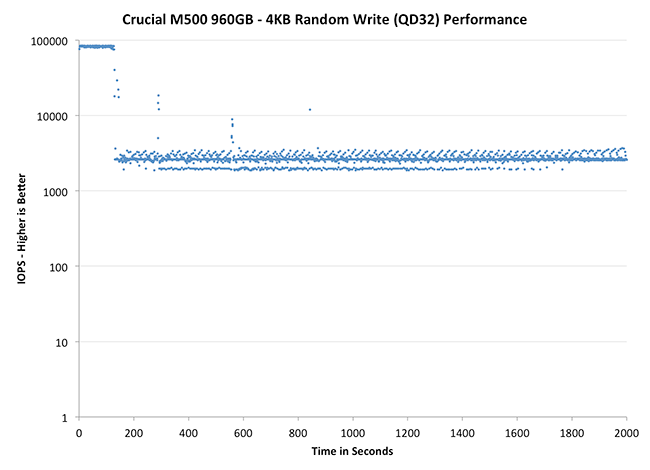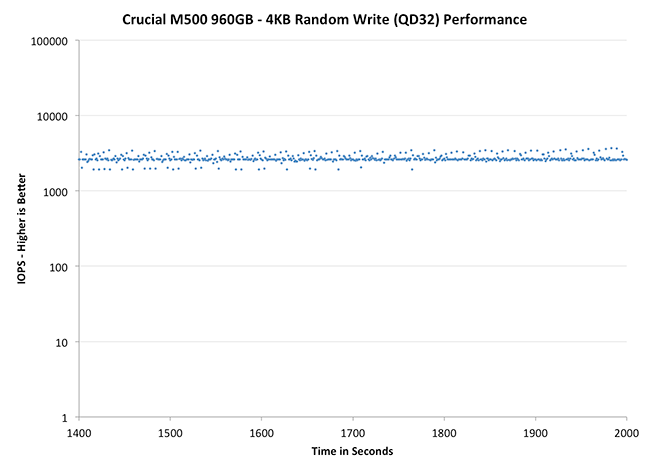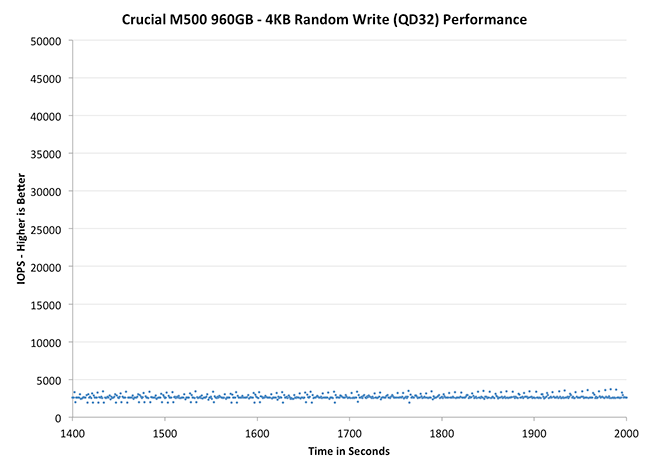The Crucial/Micron M500 Review (960GB, 480GB, 240GB, 120GB)
by Anand Lal Shimpi on April 9, 2013 9:59 AM ESTPerformance Consistency
In our Intel SSD DC S3700 review I introduced a new method of characterizing performance: looking at the latency of individual operations over time. The S3700 promised a level of performance consistency that was unmatched in the industry, and as a result needed some additional testing to show that. The reason we don't have consistent IO latency with SSDs is because inevitably all controllers have to do some amount of defragmentation or garbage collection in order to continue operating at high speeds. When and how an SSD decides to run its defrag and cleanup routines directly impacts the user experience. Frequent (borderline aggressive) cleanup generally results in more stable performance, while delaying that can result in higher peak performance at the expense of much lower worst case performance. The graphs below tell us a lot about the architecture of these SSDs and how they handle internal defragmentation.
To generate the data below I took a freshly secure erased SSD and filled it with sequential data. This ensures that all user accessible LBAs have data associated with them. Next I kicked off a 4KB random write workload across all LBAs at a queue depth of 32 using incompressible data. I ran the test for just over half an hour, no where near what we run our steady state tests for but enough to give me a good look at drive behavior once all spare area filled up.
I recorded instantaneous IOPS every second for the duration of the test. I then plotted IOPS vs. time and generated the scatter plots below. Each set of graphs features the same scale. The first two sets use a log scale for easy comparison, while the last set of graphs uses a linear scale that tops out at 40K IOPS for better visualization of differences between drives.
The high level testing methodology remains unchanged from our S3700 review. Unlike in previous reviews however, I did vary the percentage of the drive that I filled/tested depending on the amount of spare area I was trying to simulate. The buttons are labeled with the advertised user capacity had the SSD vendor decided to use that specific amount of spare area. If you want to replicate this on your own all you need to do is create a partition smaller than the total capacity of the drive and leave the remaining space unused to simulate a larger amount of spare area. The partitioning step isn't absolutely necessary in every case but it's an easy way to make sure you never exceed your allocated spare area. It's a good idea to do this from the start (e.g. secure erase, partition, then install Windows), but if you are working backwards you can always create the spare area partition, format it to TRIM it, then delete the partition. Finally, this method of creating spare area works on the drives we've tested here but not all controllers may behave the same way.
The first set of graphs shows the performance data over the entire 2000 second test period. In these charts you'll notice an early period of very high performance followed by a sharp dropoff. What you're seeing in that case is the drive allocating new blocks from its spare area, then eventually using up all free blocks and having to perform a read-modify-write for all subsequent writes (write amplification goes up, performance goes down).
The second set of graphs zooms in to the beginning of steady state operation for the drive (t=1400s). The third set also looks at the beginning of steady state operation but on a linear performance scale. Click the buttons below each graph to switch source data.
 |
|||||||||
| Corsair Neutron 240GB | Crucial m4 256GB | Crucial M500 960GB | Plextor M5 Pro Xtreme 256GB | Samsung SSD 840 Pro 256GB | |||||
| Default | |||||||||
| 25% Spare Area | |||||||||
Like most consumer drives, the M500 exhibits the same pattern of awesome performance for a short while before substantial degradation. The improvement over the m4 is just insane though. Whereas the M500 sees its floor at roughly 2600 IOPS, the m4 will drop down to as low as 28 IOPS. That's slower than mechanical hard drive performance and around the speed of random IO in an mainstream ARM based tablet. To say that Crucial has significantly improved IO consistency from the m4 to the M500 would be an understatement.
Plextor's M5 Pro is an interesting comparison because it uses the same Marvell 9187 controller. While both drives attempt to be as consistent as possible, you can see differences in firmware/gc routines clearly in these charts. Plextor's performance is more consistent and higher than the M500 as well.
The 840 Pro comparison is interesting because Samsung manages better average performance, but has considerably worse consistency compared to the M500. The 840 Pro does an amazing job with 25% additional spare area however, something that can't be said for the M500. Although performance definitely improves with 25% spare area, the gains aren't as dramatic as what happens with Samsung. Although I didn't have time to run through additional spare are points, I do wonder if we might see better improvements with even more spare area when you take into account that ~7% of the 25% spare area is reserved for RAIN.
 |
|||||||||
| Corsair Neutron 240GB | Crucial m4 256GB | Crucial M500 960GB | Plextor M5 Pro Xtreme 256GB | Samsung SSD 840 Pro 256GB | |||||
| Default | |||||||||
| 25% Spare Area | |||||||||
I am relatively pleased by the M500's IO consistency without any additional over provisioning. I suspect that anyone investing in a 960GB SSD would want to use as much of it as possible. At least in the out of box scenario, the M500 does better than the 840 Pro from a consistency standpoint. None of these drives however holds a candle to Corsair's Neutron however. The Neutron's LAMD controller shows its enterprise roots and delivers remarkably high and consistent performance out of the box.
 |
|||||||||
| Corsair Neutron 240GB | Crucial m4 256GB | Crucial M500 960GB | Plextor M5 Pro Xtreme 256GB | Samsung SSD 840 Pro 256GB | |||||
| Default | |||||||||
| 25% Spare Area | |||||||||










111 Comments
View All Comments
blackmagnum - Tuesday, April 9, 2013 - link
How times have changed. SSDs now have better bang-for-the-buck than hard disk drives. No noise, low power, shock resistance... the works.Flunk - Tuesday, April 9, 2013 - link
That's not quantitatively true. 2TB hard drives are available for about $100 which is 0.05/GB no SSD can match that.SSDs have better power usage, performance, shock resistance but they lag in capacity.
ABR - Tuesday, April 9, 2013 - link
Actually they tend NOT to have better power usage, at least when compared against 2.5" laptop hard drives. But everyone thinks they do anyway since it just seems like a purely electronic device should use less energy than a mechanical one.akedia - Tuesday, April 9, 2013 - link
I don't believe that's correct. Sure, sometimes, some SSDs in some usage scenarios might use more, but it's generally correct that SSDs use less power than even 2.5" HDDs. Below I've linked to recent (within the last year) StorageReview.com reviews for two current generation examples, the WD Scorpio Blue and the Samsung 840 Pro. The SSD beats the SSD on all measures other than writing, which over the course of time is unlikely to tip the scales, and even then they have to note that the system was tested in a desktop which didn't have DIPM enabled. So this is a worst-case for the SSD, without all of its power-saving features enabled, and it still comes out generally on top, while providing vastly superior performance on all measures.It's not true that ALL SSDs beat ALL HDDs at ALL times for ALL usages in ALL circumstances, but it's also not true that 2.5" HDDs have better power usage in general. They don't. And that's without even considering how much less time such a higher performing device would take to read or write a given amount of data, spending much less time out of power-sipping idle. Cheers.
http://www.storagereview.com/western_digital_scorp...
http://www.storagereview.com/samsung_ssd_840_pro_r...
akedia - Tuesday, April 9, 2013 - link
*editThe SSD beats the HDD on all measures other than writing, it doesn't beat itself. *facepalm*
ABR - Tuesday, April 9, 2013 - link
The SSD link you site, together with another review on Tom's Hardware, reportvery different values for power usage than most places I've seen. For example,
here on Anandtech:
http://www.anandtech.com/show/6328/samsung-ssd-840...
Generally averaging 3-5 watts, whereas good HDDs are in the 1.5-2.5 range. It would be good to know the reason for the discrepancies. It does seem that smaller processes are starting to help the SSDs catch up though.
tfranzese - Tuesday, April 9, 2013 - link
You do realize that SSD's can get their work done quicker and get back to idle much faster than any mechanical drive? Unless you're looking at a SSD that has horrible idle power characteristics there's little hope in hell for a HDD to compete as far as power efficiency goes.ABR - Tuesday, April 9, 2013 - link
What I realize is that there is a lot of hand-waving and warm fuzzy thinking in this area, but few hard numbers. The ones that I *have* seen tend to suggest SSDs are still catching up in power efficiency.MrSpadge - Tuesday, April 9, 2013 - link
+1Consuming about as much power (give or take a few 10%) for one or two orders of magnitude less task completion time results in one to two orders of magnitude less energy consumed to complete the task. And that's what really counts, for the wallet and the battery.
mayankleoboy1 - Wednesday, April 10, 2013 - link
Instead of "Power usage" , lets see the "Energy usage" of the whole system, (that is powerused*time)I strongly suspect that SSD's will easily beat any HDD here.